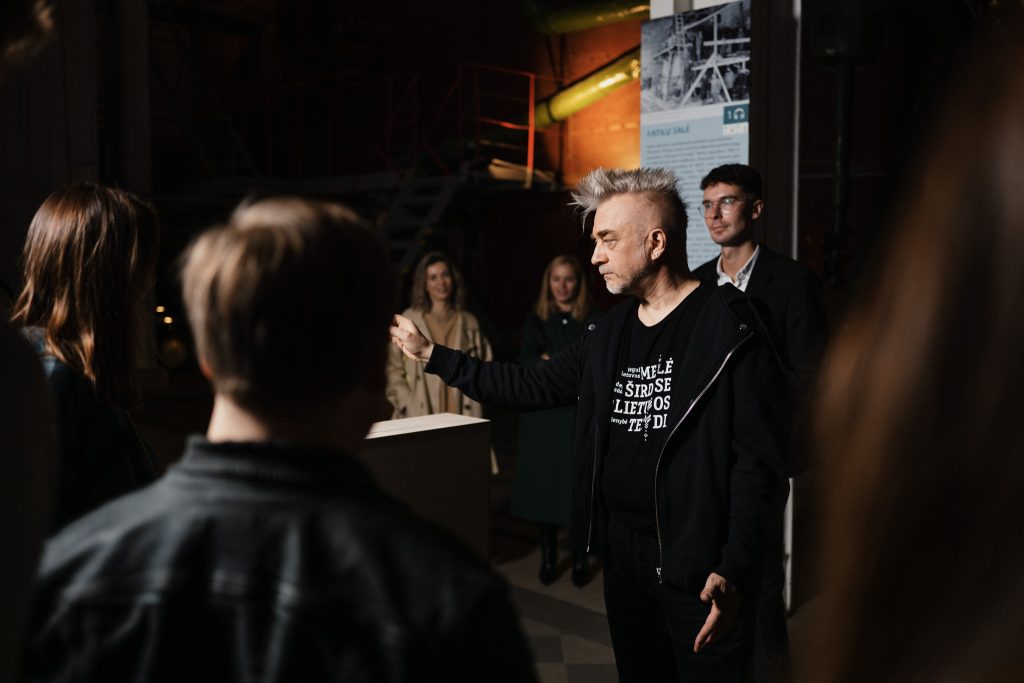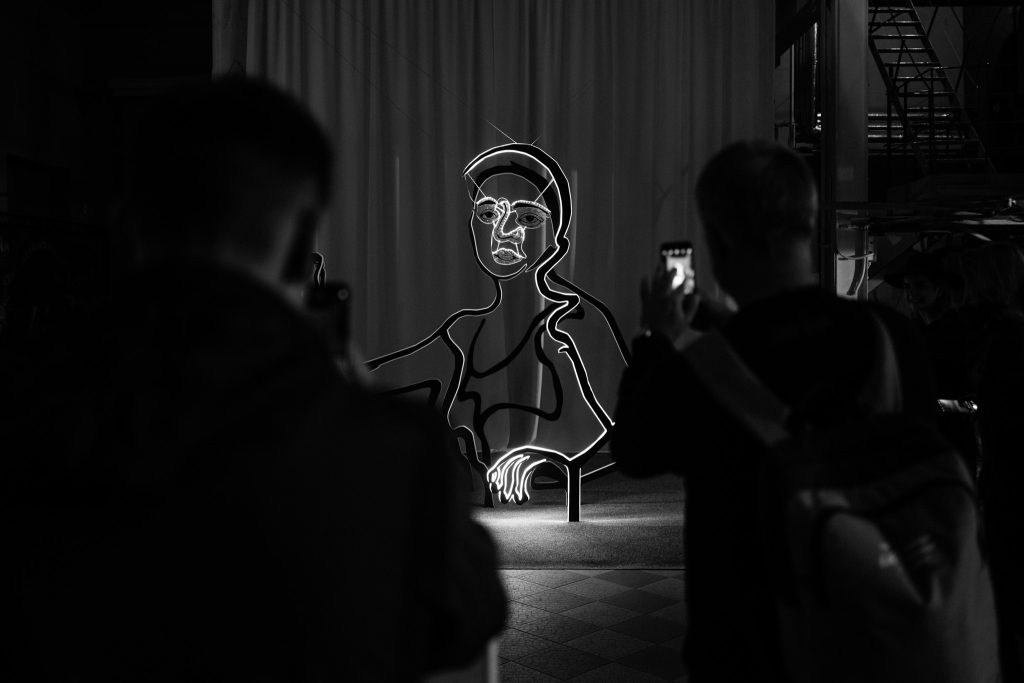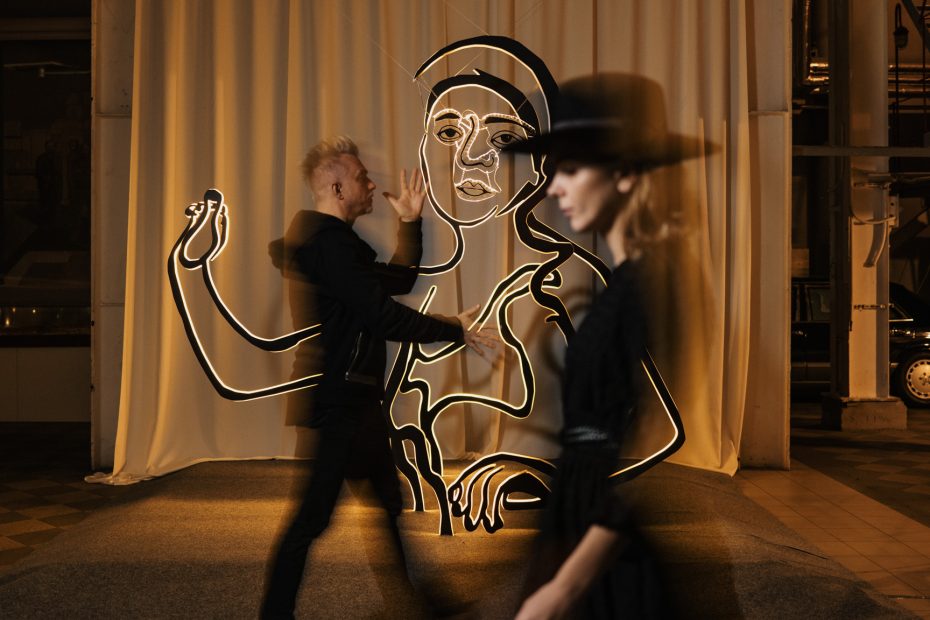At the end of September, performer, composer Andrius Mamontovas and artist Jolita Vaitkutė created their latest installation, “Electric Diva”, at the Energy and Technology Museum. The piece is dedicated to Vilnius-born electronic music star Clara Rockmore. This is already the fourth joint work of Mamontovas and Vaitkutė.
“Three years ago, we talked with Jolita about her portraits from autumn leaves. Then I asked, “Do you know who Clara Rockmore is? More specifically, Clara Reisenberg Rockmore?” And I told her the story of the origin of the theremin – that it’s the only instrument in the world that can be played without touching it. An antenna and an electromagnetic field – even nowadays it seems incredible, while in the last century it must have been something beyond this world,” said Mamontovas.


Jolita Vaitkutė. Photo courtesy of Joana Suslavičiūtė
Diva from Vilnius
The initiator of the installation is musician Mamontovas, the visual part of the installation was created by artist Vaitkutė. The authors sought to honor the talent of Rockmore, the first electronic musical instrument theremin virtuoso from Vilnius. The installation combines the portrait of the musician, with her hand raised playing a theremin, and an interactive presentation of the history of technology.
The authors chose an expression that allows not only to observe the installation, but also to enter it and extract the sounds of the theremin with your body. “Even for a musician, it is extremely difficult to play it, it requires no less knowledge or effort than playing any other instrument, as well as a well-trained ear. Clara had all these qualities, even today she is considered a great theremin virtuoso, said Mamontovas. – What’s more, she was born in Vilnius and walked the streets of the capital as a child. After all, we have an electronic music star of Lithuanian origin – electronic music was born somewhere here, in Vilnius. We can be proud of her and her story. Of course, Jolita was the person who could perpetuate, visualize and honor Clara’s memory.”


Andrius Mamontovas.
Electronic music star
“When I heard Rockmore’s story, it shocked and impressed me, Vaitkutė recalled. – The story of Clara’s life is special, and the instrument is complex, detailed, it can only be played when completely frozen, the sound floats in the air, it is difficult to catch. Because they play with the body, each person does it in a unique way – no one can play exactly the same as the other.”
Rockmore (1911-1998) was an electronic music artist of Litvak origin. At the age of five a particularly gifted violinist was accepted into the Saint Petersburg Conservatory. To this day, Rockmore remains the youngest student of the institution.
Fleeing from the consequences of the October Revolution in 1921, Clara and her family moved to the United States, where she later began her career as an electronic music producer. Due to health problems in adolescence, the musician had to give up the violin, but this led Clara to discover the first electronic musical instrument, theremin, invented in 1919.


Clara’s perfect pitch and classical fundamentals gave her an edge over many other theremin players of the era. She was in close contact with the inventor of the theremin, Leon Theremin. After noticing several shortcomings of the first instrument, she contributed to the improvement of this invention.
“The installation consists of two parts – sound and light, – continued Vaitkutė. – We suggest you try it yourself and experience it. It was not for nothing that we installed it in the Energy and Technology Museum, because the museum itself studies technology, reminds us of the development, history and processes of technology.”


“Electric Diva”.
Optical illusion
According to the authors of the “Electric Diva” installation, the Energy and Technology Museum was chosen as a place that conceptually reflects the spirit of the work. “The museum preserves and presents technical heritage. I am glad that when we talk about the operating principle of the theremin, we continue to develop the technical content and that by remembering the pioneer of electronic music Rockmore and her life story, we contribute to a lesser-known part of Lithuanian Jewish history,” said the head of the museum, Mykolas Bistrickas.
This is one of the largest and most interactive technical museums in Lithuania. “Today, in it we can also demonstrate an optical illusion, anamorphosis, and explain in an engaging way how electromagnetic and radio waves work. Most importantly, by presenting the installation to the public, we contribute to one of the main goals of the museum – to stimulate interest in the history and culture of technology in an interactive, interesting and engaging way, allowing visitors to experience the work for themselves. I am grateful to the creative team for that,” said Bistrickas.


The interactive installation is on display in the Boiler Hall and is open for visits during the museum’s working hours Tuesday to Sunday from 10 AM to 6:30 PM.
The project was supported by the Lithuanian Council of Culture, project partner – “Go Vilnius”.

